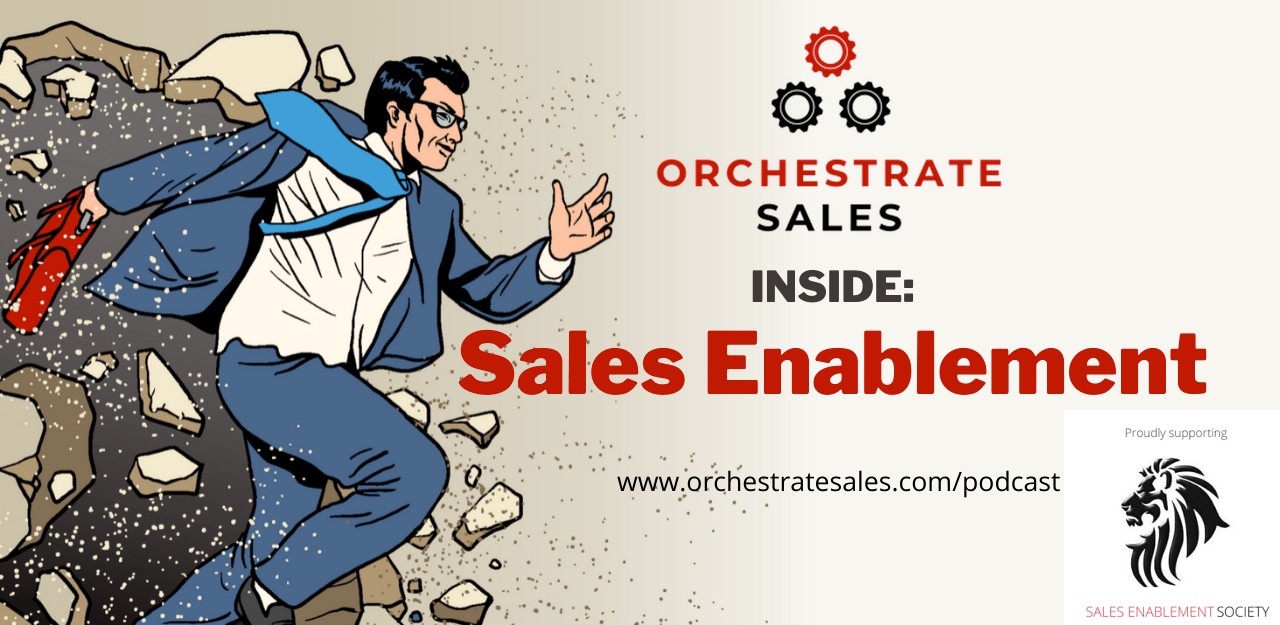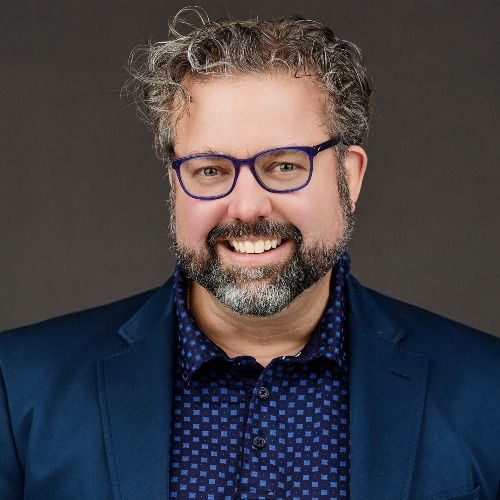Ep41 Engineering Valuable Sales Conversations with Scott King
Welcome to the Inside: Sales Enablement Podcast, Episode 41
In this episode Scott King joins the show to help "dissect" the revenue engine and discuss the wins he's accomplished in partnership with product, marketing and sales teams to drive profitable growth at his company.
We tap into their shared experiences to discuss the revenue and profitable growth "anatomy" that exists within companies and how sales enablement leaders can help decrease seller burden and elevate sales conversations at scale in partnership with sales leadership.
Join us at https://www.OrchestrateSales.com/podcast/ to collaborate with peers, join Insider Nation, participate in the conversation and be part of the continued elevation of the profession.
EPISODE TRANSCRIPT:
Intro 00:02
Welcome to the inside sales enablement podcast. Where has the profession been? Where is it now? And where is it heading? What does it mean to you, your company, other functions? The market? Find out here. Join the founding father of the sales enablement profession. Scott Santucci and Trailblazer Brian Lambert, as they take you behind the scenes of the birth of an industry, the inside sales enablement podcast starts now.
Brian Lambert 00:34
I'm Brian Lambert. And I'm Scott King. And we're the sales enablement insiders. This podcast is focused on helping you be successful overcoming sales complexity, so that your salespeople can be more effective in the market. If you're an enablement leader, looking to elevate your function, expand your sphere of influence, and increase your impact with customers. You're in the right spot. Thanks, Scott. Those of you who are longtime listeners, you heard that right. That was Scott King, not Scott Santucci. So Scott King, are you ready to take the guest host spot today? Yeah, man. I'm excited. I'm jumping into the co host seat so we can put Scott Santucci on the hot seat. I want to talk to him about engineering sales conversations. That's cool. Yeah, we've got to Scott's on here so we're gonna have fun and Santucci. Are you ready for this? We're all friendlies here.
Scott Santucci 01:24
I love the I love the script. It says say something witty.
Scott King 01:29
Say something.
Scott King 01:31
I watch God Scott.
Scott Santucci 01:33
That's a lot of pressure. Uh, are you excited? I'm excited. Yes.
Brian Lambert 01:36
All right, cool. Simmer down. Alright, so the reason why I've got this scripted is because I want to brag on Scott King. And usually what we do with leaders is where we first met them with their origin story is so Scott King and I go back a little bit, but he actually goes back to Scott Santucci even further and that was when Scott Santucci was at Forrester. And there was a conference in Phoenix, where Santucci was talking about sales as an ecosystem. And he had a keynote around the selling system. And for those of you at that event, he had this interactive exercise to map out your company's selling engine using like stickers on a on a board. And it was a big risk because people loved it or they hated it. And it was pretty cool. Since I had gone through this process of moving through and to a different company. I actually didn't meet Scott King at that event when he met Scott Santucci.
I was actually in North Carolina. I had reached out to Scott King. He's at a company called progress in Raleigh, and him and I started having conversations and I told him about podcast and he I said, Hey, do you know, Scott Santucci? And he said, Oh, yeah, I remember him from Phoenix and, and so as I got to know Scott King, I realized that these guys are kindred spirits. Scott Kane's been in sales management. He's been a seller. He's actually done cradle to grave sales enablement for seven different businesses. And those businesses event 20 million to 600 million in revenue. He's really at the forefront of digital transformation, coordinated content strategy, elevating productivity, and the product marketing and product management teams by 60%. And decreasing sales support needs and how they work to streamline and simplify the support that they're giving to sales. He's also got a competency based approach to hiring and sales success. And that's helped his organization exceed revenue goals by 100% year over year with an a team that had just seen substantial turnover. He's currently at 90% track record of new hires achieving quota within their first year. And I was really impressed with his approach because he showed me in that meeting, we had a bit of a whiteboard discussion around his frameworks and tools and how he was thinking about sales enablement. So I said to myself, here are two guys that have been on parallel paths. they've they've met each other once in Phoenix, they know of each other. And they've built their own sales enablement approaches. And I thought it would be good to come together on the podcast today to talk about what that looks like. So Scott King has has a copy of engineering valuable sales conversations. That's a report that Scott had written over 10 years ago when he was at Forrester, that's our centering document. It's 10 years old. So we're going back in time a little bit and now here we are, so Santucci this is not not a trial, like our listeners might be familiar with the the trial of the decade. This is not a trial. You guys are both colleagues and I got to ask you, Scott Santucci, we usually start with a centering story. So I have to take you back to 1827
Scott Santucci 04:46
I love it.
Brian Lambert 04:49
1827 do you know Henry gray
Scott Santucci 04:53
in 1827? Yeah. Henry Clay Henry gray like the South Carolina senator
Brian Lambert 05:01
Oh, no, no, that's not the one I'm thinking about.
Scott Santucci 05:05
Is it clay? See Ray?
Unknown Speaker 05:07
A Why? Or like the color gray? Oh, Henry gray.
Unknown Speaker 05:11
I've no idea who that is.
Brian Lambert 05:12
Okay. Well, he was born in 1827. And he studied the human body. And he studied the development of endocrine glands in the spleen. He was an expert in spleen science. He was appointed a lecture on anatomy at St. George's Hospital in London. In 1855, he approached his colleague, Henry Van Dyck Carter with this idea to produce an inexpensive and very accessible textbook for medical students. You know what that textbook was? It was the Grey's Anatomy book, The Grey's Anatomy book in 1853. So how would he do it? Well, following the laws that were passed in London, which was called the workhorse and hospital mortuaries act, in 1832, he could actually collect bodies from the morgue and dissect them. Yes. So he did that. And he worked 18 months on this book to make the human body accessible. And that name of the book was called the Grey's Anatomy book. There you go.
Unknown Speaker 06:18
So not the TV show. Turns out,
Unknown Speaker 06:20
not the TV show, right?
Scott Santucci 06:22
So this is the part where we're supposed to say so what, like, What in the world are you talking about here with this book, and I love being on the other end to get really, really channeled? So what so what what are you talking about? Was that anything to do with me and Scott King?
Brian Lambert 06:38
And or sales enablement?
Scott Santucci 06:40
Well, right, now, we got a guest on the show, right?
Brian Lambert 06:44
Yeah, I think, from my perspective, I think this is a it's a, it's a great starting point, I'm a little bit embarrassed to, you know, kind of admit my, you know, kind of entree into sales enablement, kind of rolling out of the field was that that event there in Scottsdale, so, you know, for me, kind of, I guess, the world started the day I was born that way, I didn't kind of look back at the, at the research that was available. So, um, you know, up until very recently, I wasn't aware that this engineering, the conversations kind of structure existed. So as I was going through it, you know, for me, there's a lot of lessons that I could have learned by not running through brick walls. And that's why I'm excited to kind of talk about this report. I know that it has been around for a while.
For me, it was new, and seems still very, very relevant. So I appreciate you guys kind of even you kind of sharing this with me, because, you know, from my perspective, it started with those stickers, and I'm a sucker for stickers and colors. Right. But I think from from my standpoint, what I'd like to do, Scott is is kind of dig in on on kind of maybe four buckets as it relates to this report and kind of how that applies to today, and what changes might be made or kind of some of the different ways that that maybe I've approached it, but the way I'm looking at it is, what is the scope? So if we've, if we've defined it, as, you know, profitable revenue growth, as it relates to this report, and as it relates to kind of the research that you guys had done a number of years ago, how did you define the scope? What do you see the scope is being? And then kind of digging down from there into? What are the components of, let's say, the anatomy? What are the components? What are the big, you know, the big organs that we're going to be concerned about, and then kind of dig down from there into the critical integration points, and then kind of taking a look at the critical parts that we could potentially dig into. I don't know if you think that sounds like a fair approach. But that was kind of the way I was, I was thinking about having the conversation.
Scott Santucci 08:42
No, it sounds great. Happy to follow your lead here. Doctor, I
Brian Lambert 08:49
think it should be scary for all of us, actually. Um, well. So yeah, as I was going through your report, and maybe it does make sense. And I'm sorry, Brian, maybe it does make sense to kind of just if you wouldn't mind kind of give us that that high level view. And the in the initial report that you did is you defined what the goals were of the CEO and the different kind of business structures that you saw, how did you come to that kind of gauge, if you can give us kind of a high level view of what those things are for those people that don't have the report sitting in front of them? To me, it was it was really insightful as a as a starting point for how revenue is impacted by organizations and how they have to align to it to achieve that goal.
Scott Santucci 09:33
Sure thing, so having had a bad carrying sales role before and then also having been a VP of sales. As the bad carrying salesperson, you think the VP of Sales has a lot of control over your destiny, and then when you're a VP of Sales and Marketing, you realize, oh my gosh, the board here really has a lot of sec or has a lot of We'll call it input. The CEO has a lot of input. So there's a lot of expectations that as a newly crafted VP of sales, sales and marketing, I was honestly dumbfounded and shocked at how little the board and the CEO really understood about sales. So what you learn is, Oh, my gosh, this is a community wide thing, it's a team sport, I can carve out my turf. But what I'm going to do is I'm going to sign up for 100% of the number, and then the products and everything like that the things the rest of the organizations doing that impact, our team's ability to hit the numbers isn't working. So that illuminated a holistic problem. And, you know, I carried that around with me, and I thought that was my own insanity. You know, like, there must be something wrong, there's got to be a way to do it better and alike. And then I joined Forrester, and we had a variety of working sessions with VPS of sales and VPS of marketing. And sure enough, they have the same problem that they call the different things, you know, because these situations that we run into, are going to be symptomatic by by the lens that we see it.
So for example, sales might say, well, we don't have we don't have the right products. Or they might say our marketing is bad. Marketing might say, well, salespeople don't know how to how to bring it up, or they don't know our customers well enough. And when you frame problems, that way, you don't get really you don't get really curious. So what we did is we brought a variety of we brought 10 VPS of sales and 10 CMOS together and said, you know, figure this out, let's let's figure out where these gaps are and put some texture around it. So that's, that's really the driving force. And then you know, sort of to do that is knowing full well that both of those parties, even if they do come together, you're going to have to have something to connect back to the CEO, because the CEO is definitely going to be involved in anything that's dealt with cross functionally, how do we go do that? So you know, the answer there was to read, I don't know, 50 annual reports. And then specifically, the q&a section and the earnings calls, and just highlight the areas, we printed all those out and highlighted all the areas where questions from the investors, we're about sales and marketing execution, and then try to put all those things together, you know, while highlighting this theme of Mad scientist's this Frankenstein, Frankenstein picture of all these pieces together. That's that's how we scoped it out.
Brian Lambert 13:00
Yeah, what I liked what I liked about the scope when I when I was reading this, and is this is absolutely not where I kind of began my journey with with enablement, I think, you know, for me, instead of looking at the whole body, maybe I articulated it, that I thought I was looking at the whole body, but in reality, I was looking at, you know, something specific, the respiratory system. And, you know, you go about trying to kind of fix that component thinking it's going to, you know, fix the body, and it doesn't, I think you brought up a couple of good points, especially in this report. And then again, which is, you know, kind of the, the creating an overarching go to market strategy is a cross functional, you know, kind of process. And, and sales really is the cap end, and from my perspective, or the execution arm of that go to strategy or go to market strategy.
And I think a lot of times, because we don't necessarily look at it as a whole, we take each individual and then ask if they're playing well together. I think there's a lot of opportunity, where, you know, the the marketing executives speak with a different language than the sales executives, right. And we kind of have to look at what those translations mean, as you're trying to drive to a, you know, kind of a larger goal. What I yeah, I just, I really felt like it was important. And it took me a long time. And once again, I'm embarrassed, I didn't I didn't get to this information earlier. But I really wasn't framing. I wasn't framing the problem, I was trying to solve at a high enough level, to I think, at least for the first couple of years, to really be able to dig in and actually start to solve, you know, kind of real problems that that, that we're going to actually help the revenue versus kind of just digging into exactly what you're talking about, which is the name calling. Well, our leads are terrible. And then you dig into the leads or you know, and at the end of the day, if I've got somebody with a heart condition, why am I Why am I fixing a sprained ankle, and I think that we have a tendency to want to do that. Mm hmm. What I really liked was then kind of how you broke that into The different styles of companies as it related to sales kind of describing the way that people kind of looked at their go to market process and what that what that motion looked like through through sales. Do you have a second? Maybe you can kind of describe what that looked like the the product base versus solution based kind of conversation?
Scott Santucci 15:21
Is that the coping with complexity part?
Brian Lambert 15:24
Yeah, I just, I really, I really feel like it says a lot if you're, if you're a sales leader, or a sales enablement leader, to me, taking a look at what the expectation is that the, of the sales team, given what they've been handed by product marketing by human capital, you know, by the sales management team, or sales operations, the structure that's put in place, I really liked the way that you did the engagement model around, you know, the commodity perception, I think we all sort of falling.
Scott Santucci 15:54
Okay, I gotcha. I like you. So one of the things that's really difficult is, for those of us that are a little bit older, and you remember the 70s, if anybody had cancer, your your grandparents or parents would whisper it be like, Brian Lambert, did you hear what happened to him. And here we are in 2020. And the diagnostic of cancer is so good, the survivability rate is so high, when you when you capture it in pretty much all forms, like pancreatic cancer used to be a death sentence. And it's got a survivability rate of 90% if they catch it early. And that phenomenon of medical science and being much more informed by just saying, look, half of the battle is we just have to talk about the problem. And the reason I that the reason I bring that up and frame that out that way is the problem that we've got is mismanaged complexity. And how many organizations do you know or people want to talk about complexity, I don't have time for that is the fingers in your ears with that.
So what we wanted to do is say, look, this complexity, and by complexity, we mean the information, the valuable information that's being transferred between your buyer and your seller. That's really the root of why you have so much inefficiency at the point of sale, your customers world has gotten has gotten more complex, your world has gotten more complex. So let's call a spade a spade. And the thing that we need to address is complexity. So that's, that's part one. So then the issue is whether you are addressing the complexity, or you're choosing to not address the complexity, like treat the symptoms, you still have a strategy, a default strategy strategy is being is happening, you are dealing with it. So if you are dealing with it by not confronting it, well guess what happens? The product, the people who are producing the messaging, maybe product marketers, product, people are producing lots of product based stuff. They're throwing it over the wall to sales, people who don't know how to discern it. And then they push that product based information onto customers. So basically, we're forcing our customers to deal with our complexity. And what do they do? Scott, you and I both know, Brian knows this too, as salespeople, if you give customers a whole bunch of stuff, when you leave, they throw all that stuff in the trash can.
Brian Lambert 18:32
That's Yeah, I agree with you. Right. And I also think there's an...




